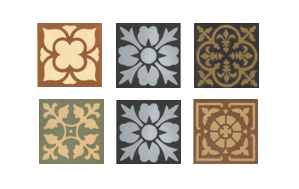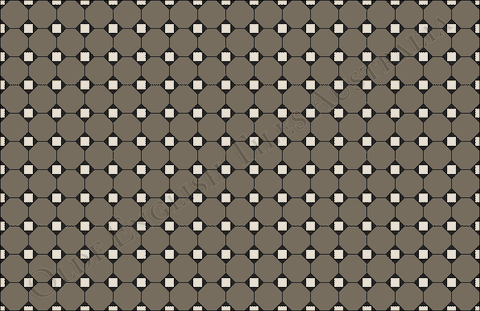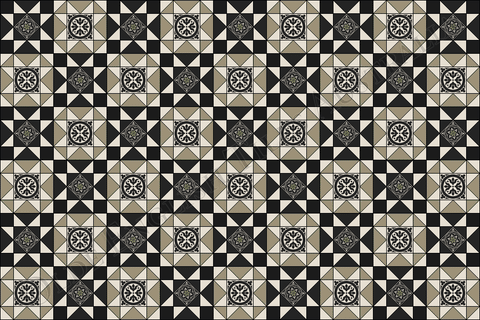The Right Design
With a myriad periods and styles in Australian architecture, we'll help you find the right pattern for your home.
In 1788 a group of Europeans landed on the shore of a harbour in a land they knew nothing about; one that was as different from their homeland as it was possible to be. Apart from the store of supplies (food, livestock, tools, weapons) they brought with them, they also brought their cultural values, their Georgian notions about how to build and decorate their homes and civic buildings.
Georgian architecture was rational, mathematical and sophisticated, exhibiting a sense of balance, symmetry and exact proportion, employing simple geometric shapes, a restrained colour palette, and limited materials.
Get the Colonial look
Rational, mathematical & sophisticated.-
Monochromatic Colours
Primarily light to dark shades in a desaturated hue i.e. White, Black, Charcoal, Light Grey, Off White -

Explore tessellated stone
Combine stones such as sandstone, marble, slate and granite with tessellated tiles. -

Simple Tessellated Geometry
Patterns were reflective of the era's style: clean, ordered and rational.
Patterns we suggest:
Simple geometry & monochromatic coloursVictorian
Despite the plethora of architectural styles during the reign of Queen Victoria, the two that were primarily responsible for the dramatic change in flooring were Italianate and Victorian Gothic, though as far as tessellated patterns were concerned, there was no (significant) difference made between the two styles.
All patterns employed in the earlier periods, plus all the additional patterns in the Olde English Tiles ™ range are suitable for this era. Paths were not always the same pattern as the verandah, a practice that became more common in the economic boom of the 1880’s. The use of encaustics was also more prevalent during this period.
Get the Victorian Look
Expressive patterns & vivid colours-
Vivid Floor Colours
Components were primarily earth tones, with accents of bold colour and ‘non-earthy’ tones like: aqua, pale green, dark green, pink and mauve. -

Use of Vitrified Porcelain
Vitrified Porcelain became very popular as a material in tessellated tile floors in the late 1800's. The Olde English Tiles tessellated and mosaics range is Vitrified Porcelain. Learn more -

Multi-Coloured Encaustics
This era sees a great deal of Encaustics used in the design of the pattern. Encaustics in this era were often multi-coloured (as opposed to single-coloured in Federation homes).
Patterns we suggest:
Simple Classics through to very ornate designsFederation
Three of the most important stylistic influences on architecture and design of the period were the Arts & Crafts Movement, Continental Art Nouveau, and the English Queen Anne style. Federation Queen Anne was the dominant architectural style in Australia between 1890-1910.
William Morris’s medieval inspired approach to design had a gradual but significant effect on tessellated floors. Whilst initially they continued to exhibit elaborate patterns, they were less likely to employ the vivid, non-natural, non-earthy colours. Likewise, multi-coloured encaustics began to disappear from floor patterns.
As with any new trend or style, not everybody responded at the same time in the same way. This was a period of profound change, with a profusion of new ideas, new styles, and new products - some of which had more traction than others.
Get the Federation look
Earthy Colours & single-coloured encaustics-
Earthy Colours
Replace vivid colours with Australiana earthy colours and subtle tonal harmony. -

Modestly complex patterns
Slightly less complex than Victorian, with the Octagon & Dot surging in popularity in this period. -

Single-Coloured Encaustics
The use of single coloured encaustics (e.g. black on white) endured well into the first decade, but not multi-coloured encaustics.
Patterns we suggest:
Simple to Mid complexity patternsArt Deco

Art Deco celebrated the exciting, dynamic aspects of the machine age and unlike the abstract, cerebral International/Functionalist style, Art Deco made a direct appeal to the emotions by the use of vivid decorative elements which served no particular function. Decorative motifs also reflected the major artistic and archaeological discoveries of the era
There are two distinct types of Art Deco - the early European phase, with more organic shapes, and numerous ancient influences e.g. Greek, Egyptian, etc, and the later, American phase, where machinery & science are the inspiration. Shapes are more geometric, and colours are more suggestive of hard-edged modernity.
Get the Art Deco look
Mosaics in classic, elegant colours-
Classic Colours
Colour schemes that embrace hard colours like Yellow, Black, Grey and White reflect the boldness and almost luxurious character of the period. -
Use Mosaics
Mosaic tiles enable the characteristically angled patterns and geometric accents that were so pertintent to the style. -
Embrace Angular Motifs
Motifs such as the chevron, zig zag and stepped forms hark back to this era, and are great elements to any floor or wall Art Deco project.
Patterns we suggest:
Embrace mosaicsCalifornia Bungalow
1915 - 1940
In the early years of the 20th century a distinctive brand of domestic architecture evolved in the suburbs of Los Angeles, which expressed the outdoors-oriented, relaxed lifestyle favoured by Californians, and subsequently Australians. 'Earthy' materials, such as klinker bricks, water-worn river pebbles, rough-cast, weatherboards, and timber – lots of timber, were common building materials. Roofs were low-pitched, with spreading eaves projecting out over wide verandahs and sleep-outs.
At much the same time, Australian architects were designing their own interpretation of California Bungalow. By the 1920's, speculative builders had embraced the form and it became the dominant style of suburban domestic architecture until the Great Depression put an end to all construction.
Get the California Bungalow Look
Similiar to Federation-
A warm colour palette
Very similiar to Federation – a restricted colour palette of warm, earthy tones to match the signature brick exterior. -

Tessellated Tiles & Mosaics
Patterns lack the ‘cruciform’ structure that so strongly characterizes Gothic Revival patterns. -

Single-Coloured Encaustics
The use of encaustics used sparingly (in Cali Bungalow) throughout the design, add pops of flair and character.











































